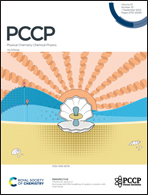Multi-wavelength excited triplet–triplet upconversion microcrystals based on hot-band excitation for optical information encryption†
Abstract
Multi-wavelength hot-band excitation, forbidden in the conventional Stokes fluorescence mechanism, is found to be available with cascading triplet–triplet annihilation upconversion (TTA-UC). Selective excitation of Pt(II)octaethylporphyrin (PtOEP) by diode lasers with wavelengths of 532 nm, 589 nm, 635 nm, 655 nm, and 671 nm respectively can all induce 9,10-diphenylanthracene (DPA) to emit blue upconversion, with the maximum anti-Stokes shift of 0.95 eV in the microcrystals exposed to air. Whether the zero-vibrational energy level excitation or the hot-vibrational energy level excitation in the ground state, the PtOEP/DPA pair showed triplet–triplet energy transfer (TTET) efficiencies approaching ∼95%. The doped microcrystal samples without encapsulation can emit blue upconversion from green/yellow/red excitation with stability for ∼20 days under atmospheric conditions, demonstrating their potential applications in multiple information encryption.



 Please wait while we load your content...
Please wait while we load your content...